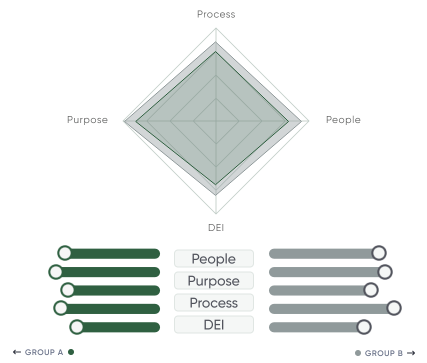The Importance of Measuring Organizational Culture

Related Insights
Can you imagine living without electricity? We would say goodbye to the internet, the device you’re reading this on, modern lighting, and air conditioning. Life would be very different. And it goes without saying, but it hasn’t always been this way.
It was not until the mid-1700s when Benjamin Franklin allegedly attached a key to a kite. The following centuries saw an explosion in research that took this natural phenomenon from an observed but misunderstood reality to a central aspect of our lives. Now, it’s hard to imagine life without it.
Similarly, an increasing focus on organizational culture has captured public attention and intrigued the minds of leaders across industries although – like electricity – it is hard to define and requires much observation. The Society for Human Resource Management, SHRM, explains that “culture is a nebulous concept and is often an undefined aspect of an organization.” We’d offer that culture is simply the sum total of behaviors within any group of people – whether team, department, or organization.
Yet even with a definition, a simple question arises: why should we care, let alone do something about it?
Today’s research shows strong cultures boast numerous benefits including increased productivity, decreased expenses, greater profitability, lower turnover, and greater share price over time to list a few. Who wouldn’t want these results? The answer seems self-evident. So, the question naturally becomes: is there a simple way to understand culture and crack the culture code to achieve these results?
One place to start is using a culture survey. Despite the overwhelming number of surveys, each with its own model and statistical backing, these surveys can help demystify and tackle the daunting task of measuring, understanding, and improving your organization’s culture. These surveys help guide you on the road to improving culture and achieving results in four ways:
1. Measurement informs better decision-making.
Measurement takes many forms ranging from formal organizational culture surveys to casual, in-person conversations. Yet they each have the same intent: an increased understanding that leads to better decision-making. Despite the method, measuring culture can provide insight from all people within your organization to identify what is working and what is not.
One of the best teams I was part of was a childhood soccer team. Aside from the joy of getting outside and playing with friends, it taught me many life lessons. One such lesson came from our halftime conversations. Amid sips of juice packs and bites of oranges, we would discuss what went well in the first half and what did not. These conversations provided a concrete avenue for our coaches to share their knowledge and for the players to share their on-the-field experience. This knowledge sharing allowed for more effective collaboration to inform our strategy in the second half.
In the same way, measuring culture sources input from all employees. Both leaders and individual contributors can share their perspectives. This provides invaluable insight into where to focus energy and invest resources.
2. Measure what matters.
All surveys have their own framework. Selecting one that measures what matters to your organization can be tricky. As an example, the Chapman & Co. Organizational Culture Survey provides data in three categories: People, Purpose, and Process. While the first two categories are well covered in a multitude of instruments, our experience tells us that the way work gets done is equally important to culture and a critical part of the equation. Regardless of the survey instrument you select, having focused information to inform your decision-making is critical to achieving the culture you wish to build.
In the context of our soccer games, our coaches helped guide our conversations to focus on areas that would tangibly improve performance. One example comes from the games when we would play on turf fields instead of grass fields. Instead of focusing on the field or other factors outside our control, we would spend most of our conversations focusing on necessary changes to our formation or offensive and defensive strategies. It was these changes that mattered and made a difference in our performance.
Similarly, culture has a myriad of facets you can focus on. Using a survey provides clarity on where to invest resources and leads to greater results from these investments.
3. Measurement builds stronger cultures.
Measurement also gives employees a voice. Doing so provides the opportunity for everyone to feel included and engage with the strategy moving forward, each of which leads to the cultural benefits we’re after.
In our soccer games, our halftime conversations provided an avenue for decision-making that was not based solely on our coaches’ perspective. It was built with everyone’s contribution. In turn, this naturally increased our buy-in and ensured the game plan was best aligned with our coaches’ strategy and each player’s needs. As a result, we were more willing to engage with the midgame adjustments.
4. Better decisions and stronger cultures increase performance.
Finally, better decisions and stronger cultures lead to increased performance. This is what we’re after. Knowing what was working in our soccer games and what was not allowed us to make more appropriate and precise changes. We were able to capitalize on our strengths and address our weaknesses.
Not only did these tactical changes improve performance, but our buy-in did as well. When we felt excluded from the decision-making, we gave up more easily and blamed our coaches. In contrast, when we felt involved, we took ownership of the changes. If they did not work, we felt responsible. As a result, we were more engaged and committed to our success.
Although my example is a childhood soccer team, the experience of working with peers and leaders toward a common goal is precisely what we do in the workplace, and culture surveys can help. Measurement gives real-time data on what is working in your culture and what is not. Using a survey involves employees in the process and provides an avenue to recognize the good and collaborate on where there’s an opportunity to improve. In combination, culture surveys provide an avenue to improve your organization’s culture and leverage it to increase performance.
As more companies embrace the need to focus on their culture, we will undoubtedly learn more about its effect on performance. However, research is already showing the impact. A focus on culture benefits both the organization and the people. With the organizational impact of culture and with an increasing majority of employees choosing it over pay, culture may soon become as fundamental and critical to your organization as electricity is to our modern lives. It will be a driving force in achieving your organization’s goals and central to what your current employees and future hires look for in the workplace.
Curious about using culture surveys to unlock your organization's potential? Let's chat about how measuring what matters can transform your workplace, just like that childhood soccer team transformed their game with halftime adjustments. We're here to help you build the culture that drives performance.






